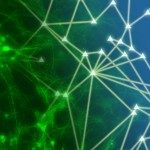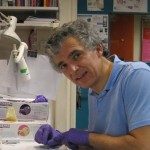Lien vers Pubmed [PMID] – 20816854
J. Mol. Biol. 2010 Nov;403(5):671-92
While interleukin (IL)-2 clearly initiates the sequential assembly of its soluble receptor fragments (sIL-2R) in vitro (with sIL-2Rα first, sIL-2Rβ second, and sγc last), the assembly mechanism of full-length subunits (IL-2R) at the surface of living lymphocytes remains to be elucidated. Here we demonstrate by fluorescence cross-correlated spectroscopy that native IL-2Rβ and γc assemble spontaneously at the surface of living human leukemia T cells (Kit-225 cell line) in the absence of IL-2 and with 1:1 stoichiometry. The dissociation constant of the membrane-embedded IL-2Rβ/γc complex is measured in situ. Förster fluorescence resonance energy transfer analyzed by confocal microscopy of transfected COS-7 cells between combination pairs of various-length receptor chain constructions, using green fluorescent protein derivatives as cytoplasmic carboxy-terminal extensions, showed that IL-2Rβ:ECFP and γc:EYFP bind each other through their extracellular domains, and that IL-2 binding brings their transmembrane domains 30 Å closer together. These observations demonstrate that IL-2Rβ/γc heterodimers are preformed and that their cytoplasmic domains, carrying Janus kinase (Jak) 1 and Jak3, are pulled and tethered together on cytokine binding, triggering signaling transduction. IL-2 binding stabilizes IL-2/IL-2R complexes in membrane nanodomains that promote Jak1/Jak3 phosphorylation. The complexes then interact with the cytoskeleton, which slows receptor diffusion (as measured by fluorescence cross-correlated spectroscopy) and promotes STAT (signal transducer and activator of transcription) 5 phosphorylation. Separation of IL-2-activated receptors from Triton-lysed cells in detergent-resistant membrane nanodomains by ultracentrifugation on a sucrose gradient confirmed their presence in lipid rafts. The release of the IL-2-activated receptor from cytochalasin-treated cells and the IL-2-induced recruitment of actin and tubulin, analyzed by immunoprecipitation, confirmed that the activated receptor interacts with the cytoskeleton. Although IL-2Rα (the third chain that gives the IL-2Rβ/γc receptor core its high affinity for IL-2) is highly expressed at the cell surface and mainly clustered in membrane microdomains at the surface of Kit-225 cells, the few free IL-2Rα present bind last to the IL-2/IL-2Rβ/γc complex and lock IL-2 to its binding site for prolonged action, promoting signal amplification.

